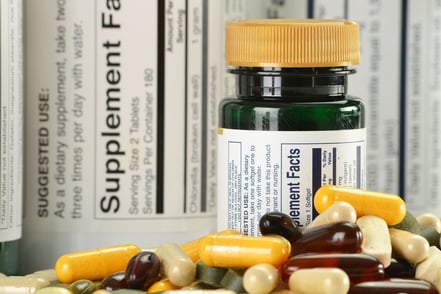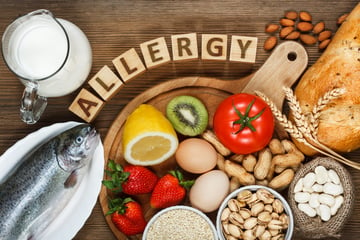 There are some distinct differences between labels for food products, which use Nutrition Facts panels, and labeling for dietary supplements that use Supplement Facts panels. But are there differences when it comes to labeling allergens? Yes and no.
There are some distinct differences between labels for food products, which use Nutrition Facts panels, and labeling for dietary supplements that use Supplement Facts panels. But are there differences when it comes to labeling allergens? Yes and no.
Labeling regulations put in place by the U.S. Food and Drug Administration (FDA), are intended to keep consumers safe and help them make informed decisions about the products they choose to consume. Whether it is a box of cereal or a bottle of Vitamin C supplements, accurate product labeling is essential to protect the consumer, ensure compliance, and help prevent a costly product recall due to an undeclared allergen.
Allergen Labeling Regulations for Dietary Supplements
Both dietary supplements and food products are required to declare the presence of major allergens on a product’s ingredient list, near the Nutrition or Supplement Facts label, as outlined in the Food Allergen Labeling and Consumer Protection Act (FALCPA) of 2004 and the Food Allergy Safety, Treatment, Education, and Research (FASTER) Act of 2021. As of 2023, there are nine major food allergens: milk, eggs, fish, shellfish, tree nuts, peanuts, wheat, soybeans, and sesame.
There are a couple FDA-approved ways that supplement manufacturers can notify customers of potential allergens: using a parenthetical in the Supplement Facts panel, using a “Other ingredients” statement when listing ingredients, and following ingredient lists with a “Contains” statement. Here are examples of what that might look like:
- On the Supplement Facts panel: protein (as whey) (milk)
- Other Ingredients: whey (milk), coconut …
- Contains: Milk, coconut
The “Contains” statement should follow directly after the list of ingredients near the Supplement Facts label and be the same font size as the rest of the ingredients. For dietary supplements that don’t include an ingredient list, the “Contains” statement should be adjacent or immediately after the Supplement Facts label.
Supplement Allergen FAQ
While identification of allergens may seem obvious – either the product has them or it doesn’t – there are a couple unique situations that supplement manufacturers may find themselves in. Here are some common questions we came across while researching this topic.
What if Your Supplement Uses Ingredients from Roots, Leaves, Stems, or Other Plant Parts From a Major Allergen?
While the term “major food allergen” refers to milk, egg, fish, crustacean shellfish, tree nuts, wheat, peanuts, soybeans, sesame, and any proteins derived from these allergens, there are exceptions. For example, the FDA states that there are allergen exemptions for highly refined oil derived from a major food allergen.
In addition, many supplements use other ingredients derived from plants that are the source of the major allergens but are plant parts that don’t contain the allergen proteins. This can cause confusion when it comes to allergen labeling, and the FDA provides this guidance to supplement manufacturers:
“Roots, leaves, stems, bark, or other parts that are distinct from the tree nut portion of the plant are not major food allergens. For example, if a dietary supplement is derived from the leaves of the Ginkgo biloba L. plant, not the Ginkgo nut, and no other ingredients containing proteins derived from the Ginkgo nut or any other major food allergen were used to make the dietary supplement, the food allergen labeling requirements would not apply to the dietary supplement labeling.”
How do You Label Source Ingredients if Sourcing From an Allergen?
In the same guidance document, the FDA also emphasizes accurately labeling source ingredients if they are derived from a major allergen. For example, sodium caseinate derived from milk, should be labeled with the proper contains statement, including milk as a parenthetical. That looks like:
- On the Supplement Facts panel: protein (as sodium caseinate) (milk)
- Other Ingredients: sodium caseinate (milk)
- Contains: Milk
The same rules apply to excipient, filler, binder, flavor, and other ingredients that derive from allergens.
What if Your Supplement is Manufactured in a Facility That Manufacturers an Allergen?
For some supplement manufacturers, depending on where your product is sourced and processed, you may also need to worry about allergen cross-contact. Cross contact can occur when an allergen is unintentionally introduced into another food product or supplement through the manufacturing, sourcing, or cooking process.
For example, a manufacturing plant may make a peanut-based protein powder, then later make a ginger root supplement; accidentally contaminating the ginger root with residue from peanuts manufactured on the same line. In these cases, manufacturers can include precautionary allergen labeling on their product, stating “may contain (allergen)” or “produced in a facility with (allergen).”
However, it’s important to note the FDA does not want manufacturers using precautionary allergen labeling in place of taking measures to prevent cross-contact through good manufacturing practices (GMPs). This is mandated under the Current Good Manufacturing Practice and Hazard Analysis and Risk-Based Preventive Controls for Human Foods rule (also known as the CGMP &PC rule), which requires manufacturers to implement practices, safety procedures, and sanitary processes to minimize the risk of spreading allergens and other food hazards. If the FDA does find a company to have inaccurate nutritional claims, undeclared allergens, or manufacturing shortfalls, they could issue a warning letter or declare a recall.
Can You Label Your Supplement as “Allergen Free”?
Currently, the FDA does not set testing thresholds for allergens, but there are a few extra steps you should take if you wish to label your supplements as either “contains no [allergen]” or “[Allergen] free.”
The best way to ensure your products are allergen free is by having samples pass allergen lab tests. Currently, you can get either a Polymerase Chain Reaction (PCR) test or an Enzyme-Linked Immunosorbent Assay (ELISA) test, which will show the presence of an allergen in the parts per million (ppm). If your results clearly show no allergens are present (and you’re sure cross-contact isn’t a potential issue at your manufacturing facility), you can safely claim your items are allergen free. However, the FDA may test that claim using their labs if they perform an FDA audit or inspection.
Ensuring Accurate Labeling for Supplements
While the allergen labeling rules for food products and supplements share many similarities, companies must be aware of the specifics to ensure their consumers are safe and can make a well-informed decision during their purchasing journey.
This is also why it’s so important to have accurately labeled Supplement Fact panels. Luckily, there are solutions that can provide the government guardrails you need to ensure your labels are FDA compliant, including automated allergen labeling when inputting ingredients. Our powerful Genesis Supplements formulation and labeling software has these sorts of features built-in so consumers can fully understand what is in your dietary supplement product. Contact our team at Trustwell today to learn more about our labeling solutions.
Other posts you might be interested in
View All Posts
Food Industry
9 min read
| February 21, 2023
5 Tips to Better Manage Food Allergens in Your Supply Chain
Read More
Product Formulation
12 min read
| January 27, 2023
Understanding Food Allergen Regulations in 2023
Read More
Food Safety
10 min read
| March 29, 2023

